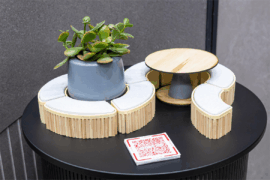One of the world’s leading names in furniture paves the way to net zero.
March 5th, 2025
MillerKnoll’s recently released “Better World Report” reveals the picture of a brand that is committed to change. Having long been leaders in the human-centred design movement, the company is no stranger to the role of trailblazer: and once again appears set to raise the standards and possibilities for furniture bands on the path to net zero. As the latest installment in a multi-year exercise, the 2024 Better World Report shines a light on both the journey and the destination for MillerKnoll, outlining their ambitious targets and canvassing the strides already made in achieving them.
Good stewards of the planet
MillerKnoll’s sustainability story is not a new one. Six decades ago, founder D.J. De Pree was making commitments to being “good stewards of the earth,” setting up an early framework through which the brand conceived itself and its operations. Today, this framework remains, with every product, every office, and every partnership evaluated against a mission to make the world’s best products in the most sustainable way.
The 2024 report lays out a holistic strategy to achieving this mission, with actions sectioned between the three pillars of planet, community, and people. Within the former of these, the subgoals of carbon, materials, and circularity reveal ambitious targets for addressing some of industry’s most complex challenges, including:
Perhaps most impressively, these goals are also set to be achieved without the use of offsets and with the mobilisation of MillerKnoll’s supply chain, with plans to set carbon baselines and reduction goals for the company’s top 25 suppliers by FY2027.
Industry Leaders
Importantly, the report is not just a forecast, but an assessment of the progress already made. In covering the company’s FY2022, FY2023 and FY2024 ESG performance, the report reveals key accomplishments, including an approximate 50% reduction in total waste since FY2022, a 52% reduction of single-use plastic packaging since 2020, the increased use of innovative materials like bamboo-based upholstery, eelgrass and biomass-balanced foam, and an energy reduction that has seen 75% of MillerKnoll’s electricity sourced from renewables.
Specific case studies are also presented, including a solar installation at the company’s largest manufacturing and distribution facility in the UK, a wallpaper production studio in the US that runs 100% on solar and uses 100% captured rainwater in its production processes, and a tale of continual evolution for the iconic Mirra Chair, which most recently was updated to have its base and spine made from 100% recycled material, cutting the chair’s carbon footprint to 64.2 kg CO2.
One of industry’s most intricate challenges also has a detailed action plan, with a dedicated program set up to address MillerKnoll’s circularity targets. The rePurpose program is an in-house initiative that has been offering customers and dealers an alternative to sending surplus and end-of-life product to landfill since 2009. With an interim goal to increase the
volume of furniture waste diverted from landfills to 4.5 million kg by FY2027, the expansion of rePurpose through Europe and Asia is an essential expansion that is not only set to help MillerKnoll but also designers and end-users the world over.
Other key interim goals include: the elimination of added per- and poly- fluoroalkyl substances (“PFAS”) in North America by FY2025 and globally by FY2027; the transition to 100% renewable electricity by FY2026; establish logistics carbon baselines and set reduction goals by FY2026; achieve a 25% reduction in the carbon footprint of top 100 products by FY2030; exceed 75% recycled content in top 100 textiles by FY2030; and achieve zero landfill for the top five manufacturing sites by FY2030, among many more.
Design for the good of human kind
In a period of time where the challenges of emissions, circularity, and waste can seem insurmountable, MillerKnoll’s progress shows that it can be done, and their commitments prove that it can be done better, and perhaps even more quickly, than anyone could have predicted. As a collective of dynamic global brands, MillerKnoll’s goals cover businesses and supply chains both small and large, taking every player in the company’s ecosystem along for their journey. More than just an important exercise in transparency and accountability, the report shows that companies can lead the way on sustainability while still being viable in the market, a standard which is sure to urge others to action and make the industry stronger and more ethical as a whole.
INDESIGN is on instagram
Follow @indesignlive
A searchable and comprehensive guide for specifying leading products and their suppliers
Keep up to date with the latest and greatest from our industry BFF's!

From the spark of an idea on the page to the launch of new pieces in a showroom is a journey every aspiring industrial and furnishing designer imagines making.

Merging two hotel identities in one landmark development, Hotel Indigo and Holiday Inn Little Collins capture the spirit of Melbourne through Buchan’s narrative-driven design – elevated by GROHE’s signature craftsmanship.

In an industry where design intent is often diluted by value management and procurement pressures, Klaro Industrial Design positions manufacturing as a creative ally – allowing commercial interior designers to deliver unique pieces aligned to the project’s original vision.

2013 start-up Malaya Blonde is bringing life back into the lighting design industry, and damned if they won’t have fun doing it.
The internet never sleeps! Here's the stuff you might have missed

Director Farrokh Derakhshani joins STORIESINDESIGN podcast from Geneva to talk about the wide-ranging Aga Khan Award, which in 2025 awarded $1m to a series of winners with projects from China to Palestine.

The Simple Living Passage marks the final project in the Simple World series by Jenchieh Hung + Kulthida Songkittipakdee of HAS design and research, transforming a retail walkway in Hefei into a reflective public space shaped by timber and movement.